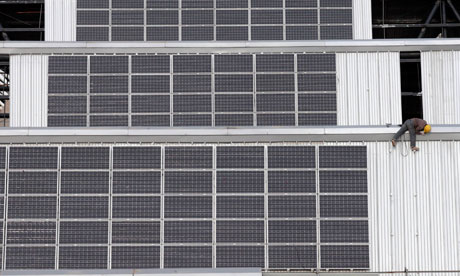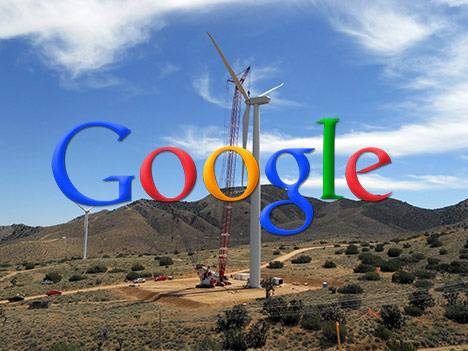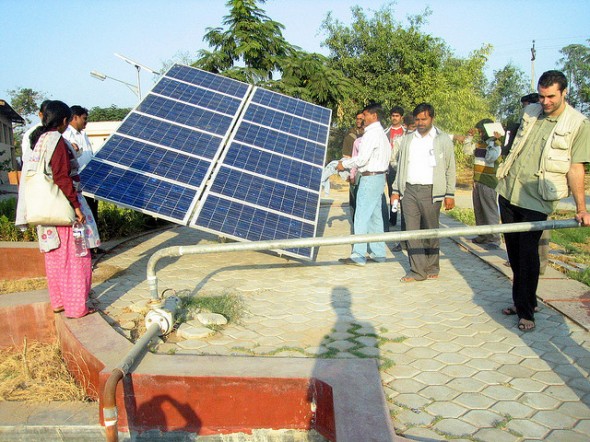Prices of solar panels are falling so fast that by 2013 they will be half of what they cost in 2009, according to a report from Ernst & Young that argues solar electricity could play “an important role” in meeting the UK’s renewable energy targets.
The average one-off installation cost of solar photovoltaic (PV) panels has already dropped from more than $2 (£1.23) per unit of generating capacity in 2009 to about $1.50 in 2011. Based on broker reports and industry analysis, the report forecasts that those rates of decline will continue, with prices falling close to the $1 mark in 2013.

The government's decision to cut feed-in tariff rates for solar panels has been criticised as 'highly damaging'. Photograph: Sean Yong/Reuters
At present, solar PV is economically viable in the UK for homeowners, businesses and investors only because of government subsidies given out via feed-in tariffs (Fits). But the new analysis suggests that falling PV panel prices and rising fossil fuel prices could together make large-scale solar installations cost-competitive without government support within a decade – sooner than is usually assumed.
The report was commissioned by the Solar Trade Association (STA) from Ernst & Young’s energy and environmental infrastructure advisory unit in response to the recent shake-up of Fits, which saw government support for large solar systems significantly reduced. This was a result of the government’s decision to cap the total that could be spent via Fits and weight the limited budget in favour of domestic and other small-scale installations.
The chairman of the STA, Howard Johns, said the new analysis backed up the industry line that government support for all types of solar systems in the next few years made good economic sense as it would build capacity and enable unsubsidised solar to be as widely deployed as possible as prices come down. “This reinforces the case we have laid out in our Solar Revolution strategy,” he said, “and it comes from an independent consultancy.”
The report coincides with new data from Bloomberg New Energy Finance that show a drastic 28% month-on-month drop in the spot price of high-grade silicon, the raw material used in most PV panels.
The conclusions of the Ernst and Young report contrast with the view of the government’s advisers, the Committee on Climate Change (CCC), which recently argued that solar remained too expensive to warrant serious consideration in the short term and that Britain should instead “buy in from overseas later”.
The lead author of the Ernst & Young report, Ben Warren, said the CCC’s view failed to consider the wider economic benefits of solar. “Being a laggard has never been very successful in terms of capturing the greater share of the value added for the economy … if you create a sustainable market, you will achieve cost savings and drive economic benefits in terms of tax income and job creation.”
To compare the relative cost of solar – usually described in terms of the dollar price of each watt of peak capacity – and other energy sources, analysts consider factors such as upfront expenditure, fuel prices, maintenance and discount rates to calculate the “levelised” cost of each unit of energy. The report predicts that, with continued support in the short term, the levellised cost of large-scale solar will be no higher than retail energy prices by 2016-19. This suggests that within 10 years companies with large electricity demands will find it cheaper to install unsubsidised solar than to buy energy via the grid in the traditional way.
In the meantime, a full assessment of the costs and benefits of supporting solar should recognise that generous subsidies help unlock new sources of capital that can speed up decarbonisation of the energy supply, according to Warren.
“The energy market is starved of capital – and it won’t all come from utilities and banks,” Warren said. “There’s a desperate need to engage with institutional investors.”
In the runup to the announcement of the Fits cuts, climate minister Greg Barker told the Guardian that Britain had underestimated the potential of solar energy and in light of falling prices he hoped to find “new pathways” for supporting large-scale solar developments.
Source

 Follow
Follow

